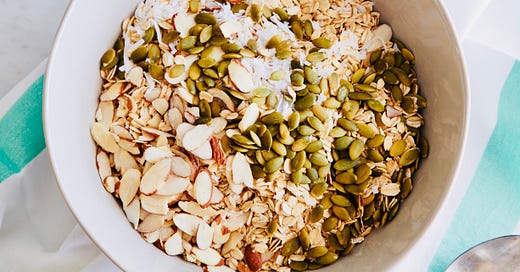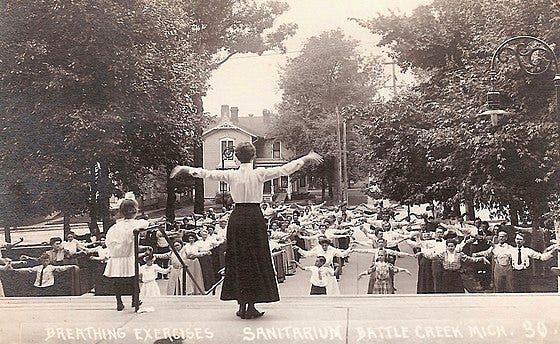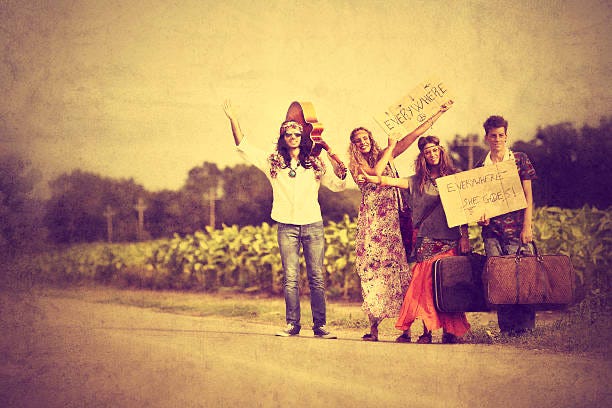A July Clean the Pantry Project: Granola! - No. 132
Cheap and naturally gluten-free with oats, nuts, maple syrup, and fruit. The Good Stuff. Plus, baking for Bastille Day 🇫🇷
SUMMER IS HARDLY THE SEASON when I get organized.
When my children were young I relished lazier mornings, later dinners, and every chance in between to get off schedule. It was our few months to unplug, recharge, and have a bit of fun before you know what started.
And part of the fun was creating things in the kitchen—popsicles, cupcakes, baskets carved out of a watermelon, and I’d make big sheet pans of granola.
Granola cleaned out the pantry and freezer of the last of the raisins and pecans, or the almonds and pepitas, dried cherries and apricots, ingredients that happened to be lurking after recipe testing for a cookbook. I never went out and bought more than oats for making granola. The rest was just there, taking up space, so to me it was smarter to put them to work in something delicious.
And ever since, granola has felt like summer.
Tell your friends about the Between the Layers summer sale because the offer on an annual paid subscription ends this Monday.
As mainstream as granola seems today, it wasn’t always that way.
Granola was born in the small New York town of Manlius where James Caleb Jackson, abolitionist and newspaper reporter, became gravely ill at 36 years. To cure himself, he took waters at a spa and became a vegetarian who forbad not just meat, but caffeine, alcohol, and tobacco and created a healthy wheat breakfast cereal to begin the day. He called it ‘’Granula,’’ with a ‘’u.’’
That was 1863, the same year as the Emancipation Proclamation and Abraham Lincoln’s Gettysburg Address and when America was in the midst of the Civil War.
A decade later, John Harvey Kellogg, a Seventh-day Adventist and owner of the Battle Creek Sanitarium in Michigan, would jump on the idea and craft a cereal of wheat, oats and corn, baked and then broken into crumbs. He called it Granula but ran into legal issues with Jackson, so renamed it ‘’Granola,’’ with an ‘’o’’ for the oats. It began the Kellogg cereal dynasty—Corn Flakes in 1894, All Bran in 1915, Rice Krispies in 1927, and Raisin Bran in 1942. (If you want to dive into a summer rabbit hole, go read about John Harvey Kellogg...)
Breakfast cereal became one of the most lucrative supermarket categories in the first half of the 20th Century, a shift from the heavy fat-laden breakfasts of days earlier. But granola just didn’t keep up. It had its fringe supporters, but it wasn’t until the late 1960s that it had a real following, a generation that didn’t want their parents’ political views or their Cream of Wheat.
The hippies embraced granola’s crunch and its connection to the land. They added dried fruit, nuts and berries, wheat germ, and redefined granola as not something you ate because your religious beliefs dictated it. It tasted good, and it was good for you. And according to the Oxford Dictionary, granola also became an adjective, defining those with ‘’liberal or environmentalist political views, typified as eating health food.”
And you know the rest is history.
Health food would sell well in the 1970s, and granola would eventually roll out to mainstream America. Here’s a Rolling Stone piece on how that all took place. Today, granola is more high-end craft than political statement. But at home, we can make our own granola that is better and less expensive than pretty much anything on the shelf.
My favorite granola recipe comes from a Nashville friend who shared it with me when our sons were in grade school together. Her son called it ‘’squirrel food.’’ It is the most delicious squirrel food you can make with maple syrup and a touch of cinnamon.
Sprinkle it onto peaches or Greek yogurt, fold it into chocolate chip cookies, or just nibble it like a squirrel, savoring a bit of almond and the last of summer.






